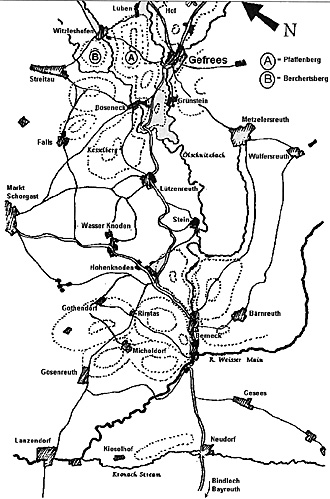The Engagement at Gefrees
8 July 1809
Order of Battle
by Jack Gill, U.S.A.
| |
Notes on Junot's TroopsComposed of six of the new 4th battalions created by Napoleon's reorganisation of the French infantry arm, the 1st Division of the Reserve Corps had been hastily assembled in April 1809 and placed under GD Olivier Rivaud de la RaffiniŠre. Ironically, given the provenance of one of his opponent at Gefrees, Rivaud had been the military governor of Braunschweig in 1807. Two of Rivaud's battalions were from regiments serving in the Army of Germany (19th and 25th Ligne from Dupas's and Gudin's divisions respectively), while the parent regiments of the other four were in Spain with Ney (50th Ligne), Soult (36th Ligne) and Sebastiani (28th and 75th Ligne). Average battalion strength was probably about 750 men at the time of the battle (Buat gives Lameth's strength as 2,159 and Taupin's as 2,397 on 15 June). The provisional dragoon regiments were constructed in April by combining the 3rd or 4th squadrons of regiments in the field: those of the 1st, 2nd, 3rd and 4th Dragoons in the 1st Provisional Regiment; those of the 18th, 19th, 20th and 21st Dragoons in the 5th Provisional Regiment. Though Napoleon intended each regiment to number approximately 1,000 troopers, it is unlikely that these two units combined had more then 1,200 men in the saddle in early July. Junot's guns were crewed by men of the 5th Foot and 6th Horse Artillery Regiments, supplemented by 22 Wurzburg train personnel picked up during the march through that duchy. The Bavarian infantrymen were from the depots of the 4th and 8th Infantry Regiments and the 5th Light Battalion, all based at the fortress of Forchheim. The two 3-pounders had been captured from one of Radivojevich's detachments on 29 June and were manned by Bavarian gunners from the depot artillery company at Forchheim. Notes on Kienmayer's Troops Unlike Junot, Kienmayer was fortunate to have a significant percentage of regulars in his command (about 37%). Even if the companies of Erbach and Mittrowsky included an fair number of new inductees, this proportion of trained line troops gave the Austrian commander an important edge over his French counterpart. The Landwehr, however, were often of poor quality. A Saxon hussar commented in his memoirs that the initials "BLW" on the Landwehr shakos stood for "Bruder Lauf Weg" ("Run Away, Brother" or, more colloquially, "the Bug-Out Boys") rather than the official "Bohmische Landwehr". Indeed, the 2nd Chrudim had been involved in a mutiny at the start of hostilities and was apparently weaker than the rest of the battalions as a result. Complete strength figures are not available, but the seven battalions most likely totalled about 4,000 men, giving an average of 550 - 600 per battalion with the 2nd Chrudim somewhat less (perhaps 350-400). The "Braunschweig Black Corps" assembled by the deposed Duke Friedrich Wilhelm generally performed well during the campaign in Saxony. Containing a large number of ex-soldiers, it was a competent force but by no means the elite band of heroes extolled by subsequent German nationalists. Its strength fluctuated almost from day to day (the two infantry "battalions" hardly deserved such an exalted title) and probably numbered about 700-900 infantry and cavalry on 8 July. It also acquired a reputation for rather poor discipline. The Austrian regulars, it should be noted, enjoyed a fine reputation for discipline and proper behaviour during the campaign in Saxony and Bayreuth, earning praise even from their enemies. The paragons of indiscipline, however, were the members of the Hesse-Kassel free corps. Organised to return Prince-Elector Wilhelm IX - a tyrannical pedant - to his throne in Kassel, it was composed of all manner of freebooters and rascals, very few of whom could claim Hesse as their place of birth (only 2.5% of the officers were of Hessian origin). Despite extravagant titles, its units were poorly trained and plagued with internal dissension; they contributed little to the Austrian war effort and received a severe rebuke from Archduke Charles for their poor behaviour. A final band of Austrian allies deserves mention: the volunteers of the "Franconian Legion". Collected by a former Hessian major named Nostitz to provide tangible proof of Bayreuth's opposition to Napoleonic rule, the legion included a company of some 205 Jagers and a squadron of 86 Uhlans (only 21 of whom were mounted) in early July. Their location on the 8th is not clear, but there is no mention of them participating in the action at Gefrees. Principal SourcesBuat, E. 1809 De Ratisbonne a Znaim, 1909.
Austrian Order of BattleCommander: Feldmarschall-Leutnant Michael Freiherr von Kienmayer Feldmarschall-Leutnant Paul Radivojevich
2nd Tabor Landwehr Bn* 2nd Chrudim Landwehr Bn* 4th Koniggratz Landwehr Bn* Meerveldt Uhlan Rgt (No.1)
Zug/Schwarzenberg Uhlans - 38 Zug/Rosenberg Chevauxlegers - 30 Zug/Blankenstein Hussars - 25 2 x 3-pdrs Oberstlieutenant Rosner (Kienmayer's Austrian troops) III/Erbach Infantry Rgt. (No. 42) - 1 bn (1,308)
2nd Leitmeritz Landwehr Bn* 3rd Czaslau Landwehr Bn* 5th Bunzlau Landwehr Bn* company/1st Jager Battalion - 1 company (157) Schwarzenberg Uhlan Rgt (No. 2) - 1 sqdn (127)
Duke Friedrich Wilhelm of Braunschweig Braunschweig Infantry Rgt - 2 "bns" (c. 250-300)
*Total Landwehr c. 4,000. French Order of BattleCommander: GD Jean-Androche Junot,Duke d'Abrantes 1st Division of Reserve Corps: GD Olivier Rivaud de la Raffiniere
Total infantry for division: c. 4500 Dragoons: GD Jean Delaroche
5th Provisional Dragoons Total cavalry: c. 1200 Bavarian Infantry (510 men): drawn from depots of 4th and 8th infantry regiments and 5th Light Bttn. Artillery: (295 men):
Bavarian: 2 x 3pdrs 
Back to Table of Contents -- First Empire #12 Back to First Empire List of Issues Back to MagWeb Master Magazine List © Copyright 1993 by First Empire. This article appears in MagWeb (Magazine Web) on the Internet World Wide Web. Other military history articles and gaming articles are available at http://www.magweb.com |